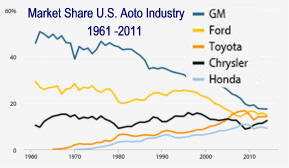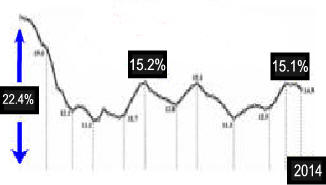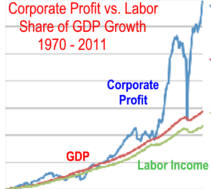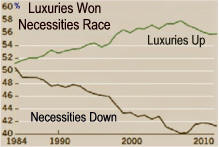Great Recession Stages
from
The Shifts and the Shocks by Martin Wolf
1. A more complex unstable financial/credits system
resulted in extreme optimism in
good times and panic in bad times. Think derivatives, securitization,
credit default swaps all
managed by hedge funds.
2. Savings glut created
as
emerging countries lowered borrowing and increased trade surpluses
after
the 1997 Asian Debt Crisis
made their foreign dollar dominate debt unsustainable. They expanded trade and kept personal consumption below economic growth. Less consumption and borrowing plus a trade
surplus increased Dollar, Euro, and Yen
reserves. Think
China and Russia.
3. Aggregate demand stagnated
as trade surplus countries didn't spend. Germany's 2005 economic
renewal was saved and Japan's private sector saved much more after
their 1990's credit bubble exploded. Adding to the demand shortage
were companies who maintained profit by decreasing capital investment
spending despite historically low interest rates. Globalization and technology also
helped them maintain profit as wage increases were limited to most valuable employees.
State and local governments, especially those with underfunded pension systems, also cut
expenditures. Think
Mercantilism. |
4. Increased current account deficits by wealthy nations balanced world trade.
Higher demand for
foreign goods
was made possible by massive central bank supported
low interest
loans. The FED's historic monetary expansion was made possible by
continued low inflation caused by expanded Flat World competition
and low oil prices. Innovative financing and lax financial regulation also fostered
expanded financial asset demand.
Think excess OPEC savings
financed the 1970's
Latin American Debt Crisis leading to Savings and Loan Crisis.
5. Real Estate and Stock bubbles came as
expected from low long-term real interest rates. New home buyers borrowed surplus savings and
investors devoured growing unique debt securities created by an expanding
finance industry promising insured difficult to understand
almost guaranteed financial instruments.
Leverage rose dramatically. Fraud, near fraud
and data manipulation exploded. See
Brief History of Financial Bubbles.
6. Poor Crisis Management by politicians as
their economic advisors believed market capitalism would prevent
serious recessions. The
Great Moderation solidified this view. Possibility of new financial
instrument contagion were not understood. When panic started,
political, intellectual and bureaucratic leaders resisted quick action in areas
that required cooperation. A
US depression was avoided by FED, Treasury and Congressional efforts
that were slowed by austerity. Iceland, Ireland, Greece, Spain and
Portugal experienced economic depression.
See
The Great Recession.
Financial Bailout, Economic Recovery, Poverty Stuck at 15%, Income Stagnates
and Wellbeing Grows 12/18/15
|




 New
Normal # 6
Profit
Beating Labor
New
Normal # 6
Profit
Beating Labor

